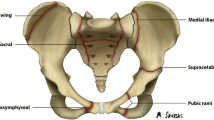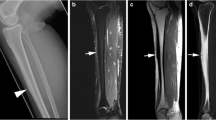Abstract
This study aims to evaluate the various imaging modalities used to diagnose tibial stress–fractures/phenomena and determine which of these are most useful and definitive. The plain film, computed tomography (CT), magnetic resonance (MR), and nuclear medicine findings in a 20-patient cohort, ranging from ages 10 to 21 years with an average of 16 years, were reviewed. The male to female ratio was recorded as was the incidence of right or left, or bilateral extremity involvement. Thereafter, each imaging modality was evaluated for positive findings. Twelve of the patients had pretibial swelling on plain films, 10 a thickened cortex, to a visible fracture on plain films and 13 had increased short-tau inversion recovery (STIR) signal in the post tibial (marrow) and pretibial (subperiosteum) areas on MR imaging. No CT studies were performed. One positive nuclear medicine study was available. Although there are a number of imaging modalities which can be used to evaluate the tibial stress/fracture phenomena problem, it would appear that plain films and MR studies are most useful. If plain films do not show a fracture and further information is required, an MR study is most appropriate.






Similar content being viewed by others
References
Tweed J, Avil S, Campbell J, Barnes M (2008) Etiologic factors in the development of medial tibial stress syndrome: a review of the literature. J Am Podiatr Med Assoc 98(2):107–111
Li G, Zhang S, Chen G, Chen G, Chen H, Wang A (1985) Radiographic and histologic analysis of stress fracture in rabbit tibias. Amer J Sports Med 13(5):285–294
Uthoff HK, Jawoski ZFG (1985) Periosteal stress-induced reactions resembling stress fractures. A radiologic and histologic study in dogs. Clin Orthop Relat Res 199:284–291
Michael RH, Holder LE (1985) The soleus syndrome. A cause of medial tibial stress(shin splints). Amer J of Sports Med 13(2):87–94
Puranen J (1974) The medial tibial syndrome: exercise ischaemia in the medial fascial compartment of the leg. J Bone Joint Surg 56B:712–715
Mubarak SJ, Gould RN, Lee YF, Schmidt DA, Hargens AR (1982) The medial tibial stress syndrome. A cause of shin splints. Amer J Sport Med 10(4):201–205
Slocum DB (1967) The shin splint syndrome: medical aspects and differential diagnosis. Am J Surg 114:875–881
Detmer DE (1986) Chronic shin splints. Classification and management of medial tibial stress syndrome. Sports Med 3:436–446
Devas MB (1958) Stress fractures of the tibia in athletes or “shin soreness”. J Bone Joint 40B:227–239
Daffner R, Pavlov H (1992) Stress fractures: current concepts. AJR 159:245–252
Allen GJ (1988) Longitudinal stress fractures of the tibia: diagnosis with CT. Radiol 167:799–801
Swischuk SE, John SD, Tschoepe EJ (1999) Upper tibial hyperextension fractures in infants: another occult toddler’s fracture. Pediatr Radiol 29:6–9
Gaeta M, Minutoli F, Scribano E, Ascenti G, Vinci S, Bruschetta D, Magaudda L, Blandino A (2005) CT and MR imaging findings in athletes with early tibial stress injuries: comparison with bone scintigraphy findings and emphasis on cortical abnormalities. Radiol 235:L553–L561
Kijowski R, Choi J, Shinki D, Nunoz DelRio A, De Smet A (2012) Validation of MRI classification system for tibial stress injuries. AJR 198:878–884
Lee JK, Yao L (1988) Stress fractures: MR imaging. Radiol 169:217–220
Fredericson M, Bergman AG, Hoffman KL, Dillingham MF (1995) Tibial stress reaction in runners: correlation of clinical symptoms and scintigraphy with a new magnetic resonance imaging grading system. Am J Sports Med 23:472–481
Horev G, Korenreich L, Ziv N, Grunebaum M (1990) The enigma of stress fractures in the pediatric age: clarification or confusion through the new imaging modalities. Pedi Radiol 20:469–471
Conflict of Interest
The authors do not have any items to disclose.
Author information
Authors and Affiliations
Corresponding author
Additional information
This is from the Departments of Radiology, the University of Texas Medical Branch, Galveston, TX, USA and Texas Children’s Hospital, Houston, TX, USA.




